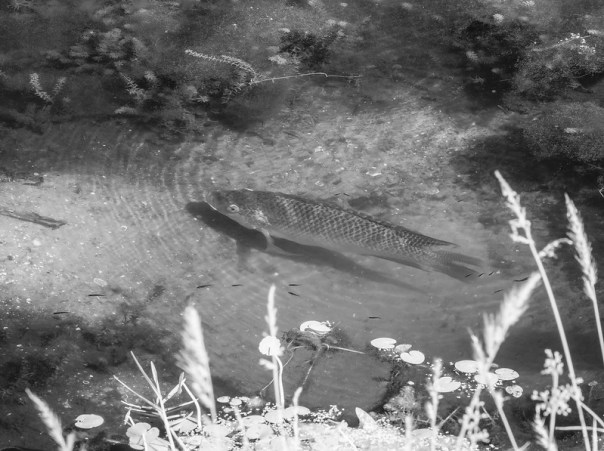I’ve visited and written about Orlando Wetlands several times this year. Now I’d like to follow-up and show you some of the things that haven’t been in the blog yet. Sorry for including so many more photos than usual – I need to catch up!
A group of Vultures resting in a tree or on the ground is called a ‘committee’. I’ve seen single Vultures pose with their wings spread before, but this was the first time I’ve seen so many, all doing the same thing, on top of identical palm trunks. It really caught my eye! It was almost like the ‘committee’ was taking a vote! If you search for “horaltic pose” you’ll find some info about this. They often do it in the early morning to warm up.
 An unusual committee of vultures
An unusual committee of vulturesWildflowers and butterflies (and dragonflies too) have been plentiful.
 Blue Iris Bloom
Blue Iris Bloom White Peacock Butterfly
White Peacock ButterflyYou may spot a snake catching some rays among the Lilly pads.

Water Snake
But the snakes have to be careful or a Great Blue Heron might spot them too.
 Formidable Hunter
Formidable HunterI’m not sure what the plants around this frog are, but they add some nice color and texture to the photo. I’m also not sure how these frogs survive in a lake with such a large population of Alligators.
 Pig Frog
Pig Frog Turtles are plentiful too.
 Mossy back turtle. Florida Cooter(?)
Mossy back turtle. Florida Cooter(?)This Caracara was strolling along the path leading to the boardwalk. I followed at a distance until it turned and I could get an image of it in profile.
 Out for a stroll
Out for a strollRed-winged Blackbirds are courting and staking out their territories.
 Singing Red-winged Blackbird
Singing Red-winged BlackbirdI heard this Pileated Woodpecker knocking from at least a quarter mile away. It kept on as I walked and the sound led me right to it.

Follow the knock
The header image is of the same bird flying toward a new place to knock. There’s a larger version here: https://www.flickr.com/photos/edrosack/52883882765/in/dateposted-public/
I didn’t hear this next one knocking, but its red highlights stood out and made it easy to find on this palm tree.
 Red-bellied Woodpecker
Red-bellied WoodpeckerPosing ducks are hard to resist.
 Black Bellied Whistling Ducks on the railing
Black Bellied Whistling Ducks on the railingAnd here’s one more Spoonbill photo. Fledglings were practicing their flying skills and learning how to get around and feed themselves. Landing on a railing is tricky!
 Young Spoonbills, exploring the world
Young Spoonbills, exploring the worldMigrant birds were also passing through Orlando Wetlands this spring. I found a Painted Bunting, a Cape May Warbler, and a European Starling – although my photos of them aren’t very good. And there’s a story over at https://birdersjourney.com/2023/04/30/life-bird-what-a-delight/ about spotting a Blue Grosbeak! So it’s been a glorious place to wander around with a camera this year. I think I’ll keep checking on it every once in a while.
Thanks for stopping by and reading my blog. Stay positive, be kind, take care of yourselves and each other. And if you can, make some photos!
©2023, Ed Rosack. All rights reserved















 Beneath the bridge, by the rocks – Parish Park in Titusville, about a half hour before sunrise
Beneath the bridge, by the rocks – Parish Park in Titusville, about a half hour before sunrise










